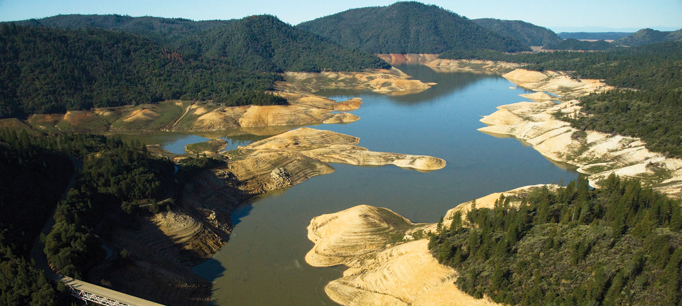This is part of a continuing series on the impact of the drought.
Drought-parched Northern California had a welcome bit of rain during the first week of February. An “atmospheric river”—a meteorological phenomenon that funnels tropical moisture from the west Pacific into California—produced prodigious amounts of rainfall. In the central Sierra Nevada more than 10 inches of rain fell in just three days. More than 20 inches of rain were measured in the Russian River watershed—an amount greater than the annual average rainfall for the City of Sacramento. Some rivers in the North Coast and Sierra Nevada that were at record low levels on February 1 rose to record highs on February 9.
Drought’s over, right?
Not even close.
Still, it is important to acknowledge how helpful this rainfall was. Small towns like Willits, which were facing emergency drought measures to maintain drinking water, got a much-needed boost to their dwindling water supplies. Folsom Reservoir, down to just 160,000 acre-feet of water before the storm (17% of reservoir capacity), added an additional 100,000 acre-feet, which will help cities in the Sacramento area. Several salmon species starting to make their way to the sea got a welcome boost down the rivers. The Delta, which was becoming as salty as it had ever been in any period in recent memory, received a pulse of fresher water. And there was the psychological boost that comes from no longer being the driest year on record.
But this recent rainfall hardly dented the drought. This year is currently the third driest on record, after the two great dry years in California history: 1923-24 and 1976-77. What’s more, this third-driest year follows two fairly dry years. And California is in a statewide drought. The bulk of the rain fell north of San Francisco, offering no relief to the very driest portions of the state and leaving most of the state’s reservoirs unchanged.
In addition, it was a very warm storm, providing little in the way of improved snowpack—normally an important way to store water until spring. And because the rainfall was so intense over such a short period of time, most of it flowed off the hillsides and into streams rather than recharging groundwater.
While impressive in the intensity and amount of precipitation, this storm did little to alter the state’s drought picture. Things may still change, but given that our rainy season has only about six weeks left in it, the odds are against much improvement.
Researchers have noted that when we think about climate, we are influenced by the weather. As John Steinbeck pointed out in East of Eden, if it is wet, Californians tend to think it has always been so and when it is dry, we forget about the wet. Our climate in 2012–2014 has been dry, but our weather, at least in early February in Northern California, has been very wet.


